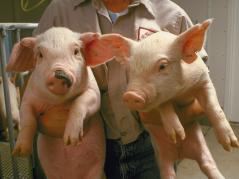|
Study Provides Nutritional Value For Co-Products From The Human Food Industry For Use In Pig Feed
URBANA, ILL.
Co-products from the human food industry offer a lower-cost alternative to cereal grains in diets fed to pigs. Research at the University of Illinois is helping to determine the nutritional value of these ingredients so that producers can make informed choices about incorporating them into swine diets, said Hans H. Stein, a U of I animal science researcher.

Researchers led by Stein conducted two experiments using corn and corn co-products. In the first experiment, they measured the concentrations of digestible and metabolizable energy in distillers dried grains with solubles (DDGS), hominy feed, bakery meal, corn gluten meal, corn gluten feed, and corn germ meal. In the second experiment, they determined the standardized total tract digestibility of phosphorus in pigs fed diets containing these ingredients without or with the addition of microbial phytase.
Corn gluten meal contained 5,379 kilocalories of digestible energy per kilogram of dry matter, more than in any of the other ingredients. The digestible energy (DE) concentrations in DDGS (4,062 kcal/kg), corn (4,032 kcal/kg), bakery meal (3,951 kcal/kg), and hominy feed (3,819 kcal/kg) were similar, but corn gluten feed (3,553 kcal/kg) and corn germ meal (3,437 kcal/kg) contained less digestible energy than all the other ingredients.
Corn gluten meal also had the greatest concentration of metabolizable energy (ME) at 4,400 kcal/kg dry matter, followed by corn (3,891 kcal/kg), DDGS (3,694 kcal/kg), hominy feed (3,675 kcal/kg), and bakery meal (3,655 kcal/kg). Corn gluten feed (3,169 kcal/kg) and corn germ meal (3,150 kcal/kg) contained the least metabolizable energy.
“The main reason DE and ME concentrations are greater in corn gluten meal than in corn is that corn gluten meal contains more crude protein and less fiber,” Stein explained.
“Hominy feed, DDGS, corn gluten feed, and corn germ meal contain much more fiber than corn, which contributes to their lower energy digestibility,” he said.
The standardized total tract digestibility of phosphorus was 75 percent or greater in DDGS, corn gluten meal, and corn gluten feed. The digestibility of phosphorus in bakery meal and corn germ meal was greater than 50 percent and in corn and hominy feed it was less than 50 percent. Addition of microbial phytase to the diet increased the digestibility of phosphorus in corn, bakery meal, corn germ meal, corn germ, and hominy feed, but addition of phytase to the DDGS, corn gluten meal, and corn gluten feed diets did not affect phosphorus digestibility.
“Different corn co-products contain different quantities of phytate-bound phosphorus due to differences in composition and processing,” Stein said. “By adding microbial phytase to the diets, we were able to increase the digestibility of phosphorus to greater than 60 percent for all ingredients.”
“Phosphorus digestibility and concentration of digestible and metabolizable energy in corn, corn coproducts, and bakery meal fed to growing pigs” was recently published in the Journal of Animal Science. It was co-authored with Oscar Rojas and Yanhong Liu of the Stein Monogastric Nutrition Laboratory at U of I. The full paper is available at http://www.journalofanimalscience.org/content/91/11/5326.full.
The National Pork Board and Nutrition Efficiency Consortium provided funding for the studies.∆
|
|